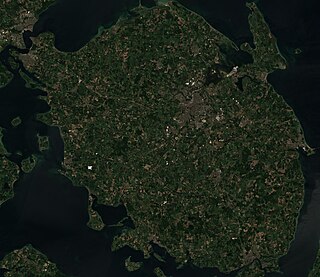
Japonic or Japanese–Ryukyuan, sometimes also Japanic, is a language family comprising Japanese, spoken in the main islands of Japan, and the Ryukyuan languages, spoken in the Ryukyu Islands. The family is universally accepted by linguists, and significant progress has been made in reconstructing the proto-language, Proto-Japonic. The reconstruction implies a split between all dialects of Japanese and all Ryukyuan varieties, probably before the 7th century. The Hachijō language, spoken on the Izu Islands, is also included, but its position within the family is unclear.

Seram is the largest and main island of Maluku province of Indonesia, despite Ambon Island's historical importance. It is located just north of the smaller Ambon Island and a few other adjacent islands, such as Saparua, Haruku, Nusa Laut and the Banda Islands.

Saparua is an island east of Ambon Island in the Indonesian province of Maluku; the island of Haruku lies between Saparua and Ambon. The main port is in the south at Kota Saparua. The small and uninhabited island of Maolana is located near its southwestern side and Nusa Laut off its southeastern tip.

Hulk: The Manga is an original Japanese manga story arc of The Incredible Hulk. It was originally published in Japan in 1970 and 1971 issues of Weekly Bokura Magazine by Kodansha. It was alternately authored by Yukio Togawa and Kazuo Koike, with art by Kosei Saigo and Yoshihiro Morito with ripped art from Herb Trimpe.
Ghari is an Oceanic language spoken on Guadalcanal island of the Solomon Islands.

The Batanic languages are a dialect cluster of the Austronesian language family. They are spoken on Babuyan Island, just north of Luzon; three of the Batanes Islands, between the Philippines and Taiwan; and on Orchid Island of southern Taiwan.

The Moluccan megapode, also known as Wallace's scrubfowl, Moluccan scrubfowl or painted megapode, is a small, approximately 31 cm long, olive-brown megapode. The genus Eulipoa is monotypic, but the Moluccan megapode is sometimes placed in Megapodius instead. Both sexes are similar with an olive-brown plumage, bluish-grey below, white undertail coverts, brown iris, bare pink facial skin, bluish-yellow bill and dark olive legs. There are light grey stripes on reddish-maroon feathers on its back. The young has brownish plumage, a black bill, legs and hazel iris.

The lazuli kingfisher is a species of bird in the family Alcedinidae. It can be found on the islands of Seram, Ambon and Haruku. Found singly and in pairs in lowland wooded areas, including cultivated areas and mangroves. Pale blue underside is unique among kingfishers in its limited south Moluccan range. Rowdy vocalizations include repetitive “ker-chick” series and “ki-ki-ki-ki…” calls. It gets its name due to its colour being reminiscent of Lapis Lazuli.

Funen, with an area of 3,099.7 square kilometres (1,196.8 sq mi), is the third-largest island of Denmark, after Zealand and Vendsyssel-Thy. It is the 165th-largest island in the world. It is located in the central part of the country and has a population of 469,947 as of 2020. Funen's main city is Odense, which is connected to the sea by a seldom-used canal. The city's shipyard, Odense Steel Shipyard, has been relocated outside Odense proper.
The Piru Bay languages are a group of twenty Malayo-Polynesian languages, spoken on Ambon Island and around Piru Bay on the island of Seram, Indonesia. None of the languages have more than about twenty thousand speakers, and several are endangered with extinction.
Leslie John Audus was a British botanist and an international authority on the hormones that control plant growth. During World War II, while being held in a Japanese internment camp, he cultured yeast to feed and save the lives of his fellow POW's.
Talaud is an Austronesian language spoken on the Talaud Islands north of Sulawesi, Indonesia. There are 2 dialects, namely Lami dialect which is spoken on Miangas, Nanusa Islands, and Esang in the northern part of Karakelang Island; Tirawata dialect is used in Lirung, Kabaruan, and the southern part of Karakelang Island.

Haruku Island is an island in Central Maluku Regency, Maluku Province, Indonesia - lying east of Ambon Island, off the southern coast of Seram and just west of Saparua. It is administered as a single district, Haruku Island District, with a land area of 150 km2 and a population of 24,207 at the 2010 census and 27,390 at the 2020 Census; the official estimate as at mid 2023 was 26,551. The inhabitants of Haruku speak the Haruku language, as well as Indonesian and Ambonese Malay.
Nusa Laut is the smallest of the three inhabited island in the Lease Islands group situated east of Ambon Island, in Indonesia's Maluku province. It lies just off the south-western corner of Saparua island, separated from it by a deep channel. The island's coasts are fringed by a drying reef.

The Lease Islands, formerly called the Uliasers or Uliassers, are a group of three inhabited islands, lying immediately to the south of Seram and east of Ambon Island in the province of Maluku, in Indonesia. The three inhabited islands, from west to east, are Haruku, Saparua and Nusa Laut, while tiny uninhabited Molana is administratively part of Saparua District; these islands constitute four administrative districts (kecamatan) within Central Maluku Regency.

Manipa Island is an island in West Seram Regency, Maluku Province, Indonesia. It is located 8 km off the western coast of Kelang at the western end of Seram Island and 25 km off the western coast of Buru. Including adjacent small islands, it forms an administrative district (kecamatan) within the regency, with its district centre at Masawoi. The district covers an area of 159.71 km2 and had a population of 7,165 at the 2020 Census; the official estimate as at mid 2023 was 7,793.

The Bikol languages or Bicolano languages are a group of Central Philippine languages spoken mostly in the Bicol Peninsula in the southeastern part of Luzon, the neighboring island-province of Catanduanes, and the island of Burias in Masbate.











